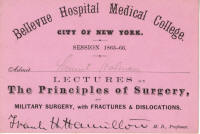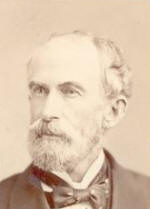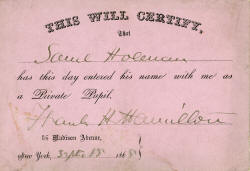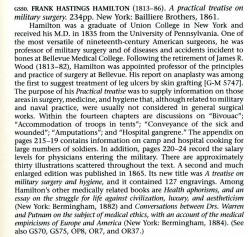Frank Hastings Hamilton, M.D.
View the book by Dr. Hamilton in this collection
He located in practice in Buffalo, N. Y., in 1844. becoming professor of surgery in Buffalo Medical College in 1846; subsequently dean of the faculty and surgeon to the Charity Hospital. In 1859 he removed to New York city to accept the chair of principles and practice of surgery and the post of surgeon - in - chief at the newly founded Long Island College Hospital. During 1861-65 he occupied the chair of military surgery, fractures and dislocations at the Bellevue Hospital Medical College, that chair being the first of its kind in the world. Meantime, during the Civil Wаг, he served as surgeon of the 31st New York infantry, which he accompanied to the front, being made brigade surgeon after the battle of Bull Hun, and later U. S. medical director. He organized the U. S. General Hospital, New York city, in 1862, and in February, 1863, was made medical inspector, U. S. army, with the rank of lieutenant colonel. He resigned his military connections in September, 1863, and resumed his private practice and instruction. FRANK H. HAMILTON. [Born in Vermont.—Appointed from New York.] Military History. — From Vermont, entered service in New York. Brigade Surgeon in the U. S. Volunteers, August, 1861. Chief Surgeon and Medical Director 4th Corps Army of the Potomac, October, 1861, to September, 1862. Charge of General Hospital, New- York City, December, 1862, to February, 1863. Lieutenant-Colonel and Medical Inspector, February, 1863. In the Department of the Cumberland, to August, 1863. Resigned? August, 1863. Died 11 August 1886. The subject of the principles of surgery being added to his chair in 1865, he continued lectures in both departments until 1858, and from then until 1875 was professor of the practice of surgery. Dr. Hamilton was visiting surgeon to Bellevue Hospital (1861-82) and consulting surgeon (1884-86); he was also consulting surgeon to the Institute for Ruptured and Crippled Children, St. Elizabeth's and other city hospitals and dispensaries. He was a member of the New York Slate Medical Society (president in 1855); of the New York Pathological Society (president in 1866); of the Medico- Legal Society (president in 1875-76); of the American Academy of Medicine (president in 1878), and of the New York Society of Medical Jurisprudence (president in 1878 and 1885), and an honorary member and officer of various other professional and learned bodies. Throughout his career he was recognized as one of the most skillful surgeons of the metropolis. He originated a safe method of cutting the sternal portion of the sterno-cleido-mastoid; was the first to operate for simple talipes where there is no disease of the joint; was the first to excise the central portion of the thyroid gland; originated the now accepted theories in relation to resection in compound dislocations of the long bones; was one of the earliest to operate for closing old ulcers by the transplantation of new skin; was the first to use gutta-percha for interdental splints; was largely instrumental in introducing gulta-percha splints for support of irregular joint surfaces, and devoted considerable attention to plastic surgery, having performed rhinoplasty more than twenty times. Among his most valuable inventions and contrivances are: a bone drill, appliances for treating fracture of the jaw and of the long bones, an improved Nelaton probe, a modified Liston artery forceps, an improved Owen toiisillotome, a serrated giant bone-cutter and other instruments equally valuable. His method of manipulating the body in asphyxia from drowning and his system of "keys" and "guides" for securing precision in amputation through the joints give him a title to enduring fame. Besides originating several new and radical operations, he was the first to work from the palm of the hand, a method now widely adopted. He was rated one of the foremost American authorities on military surgery and gunshot wounds, and on the assassination of Près, Garfield was called in consultation, remaining connected with the case until the close. Dr. Hamilton was a constant and lucid writer on surgical topics. His larger works are: "A Practical Treatise on Fractures and Dislocations" (1860, 5th ed. 1880); " A Treatise on Military Surgery and Hygiene" (1865); "Contributions "Kelaling'to the Surgery of War" (1870); "The Principles and Practice of Surgery" (1872.3d ed. 1879); a series of papers on "Prognosis in Fractures" (1855-56-57); one on "The Effect of a Sudden Loss of Consciousness on the Memory of Preceding Events" (1876), and numerous other articles, addresses and lectures. He was twice married: first, in 1834, to Mary Virginia McMurran, of Virginia; second, to Mary, daughter of Judge Oliver Hart, of Oswego. N. Y. His only daughter, Mary, is the wife of Daniel N. Davis, a business man of New York. Dr. Hamilton died in New York city, Aug. 11. 1886. _________________ HAMILTON, Frank Hastings, surgeon, born in Wilmington, Vermont, 10 September, 1813; died in New York city, 11 August, 1886. He was graduated at Union in 1830, after which he entered the office of Dr John G. Morgan, and in 1831 attended a full course of lectures in the Western college of physicians and surgeons in Fairfield, New York In 1833 he was licensed to practice by the Cayuga county medical censors, and two years later received his medical degree from the University of Pennsylvania. Soon afterward he began to give a course of lectures in anatomy and surgery in his office in Auburn, which he continued until 1838. In 1839 he was appointed professor of surgery in the Western college of physicians and surgeons, and a year later was called to the medical college of Geneva. During 1843-'4 he visited Europe, and contributed a record of his experiences to the "Buffalo Medical Journal." In 1846 he became professor of surgery in the Buffalo medical college, subsequently becoming dean, and also surgeon to the Buffalo charity hospital. Two years later he left his chair in Geneva and removed to Buffalo, in order to attend to his practice, which was rapidly increasing. On the organization of the Long Island college hospital in 1859 he was called to fill the chair of principles and practice of surgery, and was also chosen surgeon-in-chief of the hospital. In May, 1861, he was appointed professor of military surgery, a chair which at that time existed in no other college in the United States. At the beginning of the Civil War he accompanied the 31st New York regiment to the front, and had charge of the general field hospital in Centreville during the first battle of Bull Run. In July, 1861, he was made brigade surgeon, and later medical director, and in 1862 organized the United States general hospital in Central park, New York. in February, 1863, he was appointed a medical inspector in the United States army, ranking as lieutenant-colonel, but resigned in September and returned to his duties in Bellevue hospital medical college, where in 1861 he had been appointed professor of military surgery and attending surgeon to the hospital. In 1868-'75 he was professor of the principles and practice of surgery in the college, and remained surgeon to the hospital until his death. He was also consulting surgeon to other hospitals and to various city dispensaries, and in that capacity Dr. Hamilton had few equals. On the assassination of President Garfield he was called in consultation, and remained associated with the case until the death of the president. His notable operations were many, and his descriptions of improved processes are numerous. He invented a bone-drill and an apparatus for broken jaw, and invented or modified appliances for nearly every fracture of long bones, with various instruments in military and general surgery He was the first to introduce the use of gutta-percha as a splint where irregular joint surfaces require support, and the closing of old ulcers by the transplanting of new skin has been repeatedly attributed to him by French and German physicians. He was a member of various medical associations, and was president of the New York state medical society in 1855, of the New York pathological society in 1866, of the New York medico-legal society in 1875-'6, of the American academy of medicine in 1878, and of the New York society of medical jurisprudence in 1878 and 1885. In 1869 he received the degree of EL. D. from Union college. Dr. Hamilton was a large contributor to medical journals, and many of his special memoirs are accepted as authorities. His works in book-form include "Treatise on Strabismus" (Buffalo, 1844): "Treatise on Fractures and Dislocations" (Philadelphia, 1860; 7th ed., 1884, French and German translations); "Practical Treatise on Military Surgery " (New York, 1861); and "The Principles and Practice of Surgery " (1872; 2d ed., 1873). He edited a translation of Amussat on the "Use of Water in Surgery" (1861), and "The Surgical Memoirs of the War of the Rebellion," published under the direction of the United States sanitary commission (Washington, 1871). Source: Virtualology Frank Hamilton Lecture card for private pupil Sam Holman Information from Ira Rutkow: History of Medicine, p.43 _______________ 1884 Hamilton, Frank Hastings, 1886.
A. B., Union, 1830; A. M., 1833; LL. D., 1869; M. D.,
Univ. Penn., 1835; Prof. Mil. Surg. Frac. & Disloc., Bell. Hosp. Med. Coll.,
1861-65; Mil. Surg. Frac. & Disloc. & Prin. Surg., 1865-68; Prac. Surg.,
1868-75; Cons. Surg.,
|

 HAMILTON, Frank Hastings, surgeon, was born
at Wilmington, Vt., Sept. 13, 1813. He was graduated at Union College in
1830, and entering on medical study in the office of Dr. John G. Morgan and
at the Western College of Physicians and Surgeons, Fairfield, N. Y.. was
licensed to practice by the Cayuga County Medical Society in 1833. The
degree of M.I), was conferred on him by the University of Pennsylvania in
1835, and thereafter, until 1838, he continued practice at Auburn, N. Y.,
also giving courses of lectures in anatomy and surgery. In 1839 he was
appointed professor of surgery at the Western College of Physicians and
Surgeons, and in 1840 at the Medical College of Geneva, N. Y.
HAMILTON, Frank Hastings, surgeon, was born
at Wilmington, Vt., Sept. 13, 1813. He was graduated at Union College in
1830, and entering on medical study in the office of Dr. John G. Morgan and
at the Western College of Physicians and Surgeons, Fairfield, N. Y.. was
licensed to practice by the Cayuga County Medical Society in 1833. The
degree of M.I), was conferred on him by the University of Pennsylvania in
1835, and thereafter, until 1838, he continued practice at Auburn, N. Y.,
also giving courses of lectures in anatomy and surgery. In 1839 he was
appointed professor of surgery at the Western College of Physicians and
Surgeons, and in 1840 at the Medical College of Geneva, N. Y. 
